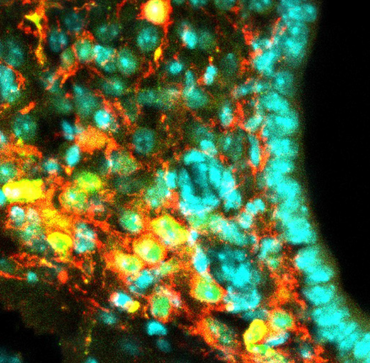The unsuspected role of a protein kinase in appetite regulation
Energy homeostasis is defined as a balance between nutritional intake and energy expenditure. It requires tight regulation to enable organisms to cope with changes in food availability. In a study published in Nature Metabolism, Romeo Ricci's team describes a new mechanism for the regulation of appetite by hypothalamic orexigenic neurons.

The central nervous system (CNS) orchestrates a complex set of processes to regulate energy intake and expenditure. Hormonal, neural and nutritional signals reach the CNS and trigger the adaptation of eating behavior and metabolism.
The detection of nutritional status is mainly coordinated by orexigenic neurons, which stimulate appetite, and anorexigenic neurons, which stimulate satiety. The latter are located in the arcuate nucleus of the hypothalamus. The satiety hormone leptin and the hunger hormone ghrelin are key players in this context. Dysfunction of these neural circuits contributes to obesity, which is the main risk factor for type 2 diabetes (T2DM) and/or cardiovascular disease.
Obesity and T2D are pathologies with a genetic predisposition: while certain genes predispose to the disease, it is the environment that conditions its development.
In this article, Romeo Ricci's team describes the function of the gene coding for CaMK1D, a gene strongly associated with T2DM. Using mice in which the gene coding for CaMK1D has been specifically invalidated in orexigenic neurons, the researchers highlight its role in regulating food intake. Faced with a high-fat diet, these mice ate less and weighed less than control mice. At the molecular level, the scientists identify a novel signaling mechanism acting in AgRP neurons to control levels of AgRP and NPY, the two main orexigenic neuropeptides involved in stimulating food intake. Thus, they highlight that uncontrolled CaMK1D signaling in AgRP neurons represents an important mechanism in the development of obesity and T2DM.

Mice in which the gene coding for CaMK1D has been specifically disabled in AgRP orexigenic neurons are resistant to the action of ghrelin, gain less weight and are protected against obesity induced by a high-fat diet. In response to ghrelin, the absence of CaMK1D no longer enables transcription factor phosphorylation (CREB) and thus CREB-dependent transcription of the orexigenic neuropeptides AgRP and NPY. Expression of these two neuropeptides is reduced in hypothalamic synaptic projections from the arcuate nucleus to the paraventricular nucleus.
Credits: Karl Vivot, IGBMC
